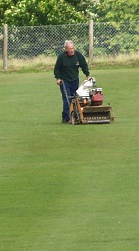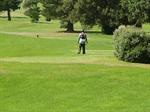WORKING IN THE TURF INDUSTRY
 A perfect lawn really looks great; but it does take a lot of work to both establish and maintain such a lawn – more work than most people realise. If you think about it, a bowling club employs a greenkeeper full time to maintain an area of lawn not much bigger than the lawn in many home gardens. If you want a better lawn you need to do two things:
A perfect lawn really looks great; but it does take a lot of work to both establish and maintain such a lawn – more work than most people realise. If you think about it, a bowling club employs a greenkeeper full time to maintain an area of lawn not much bigger than the lawn in many home gardens. If you want a better lawn you need to do two things:
- To be doing the right jobs – either learn how to do it from an expert, or hire an expert to do it for you.
- To be putting the required time into doing the work.
Winter Lawn Care
To keep the lawn in good condition over winter:
- raise the mower height to help maintain its vigour
- keep winter weeds under control, especially Winter Grass, mosses and sedges
- improve drainage – no lawn grasses thrive in heavy wet soil
- improve soil aeration – spike the lawn with a garden fork to aerate the root zone
- spread lime over the lawn if the pH is acid (below pH7). Fertilisers used over a long period can make the soil too acid
- control winter diseases – brown patch and dollar spot – using lawn fungicides and improving drainage
- use a lawn mix that includes ‘cool season grasses’ – bent, rye and fescues. These stay green throughout winter in cool climates.
CHECKLIST
If you want to improve your lawn, ask yourself:
- Am I mowing it at the best height, with the best machinery?
- Am I keeping the soil in good condition … fertile, well drained, not too compacted etc?
- Am I keeping it watered in dry weather?
- Do I have the best varieties of grass?
- are lawn weeds being kept under control?
- Are pest and disease problems always controlled?
- Is it protected from over-use and is any damaged turf repaired or replaced?
WHAT A LAWN EXPERT SHOULD KNOW
To maintain a top quality lawn, you (or the lawn expert you employ) should be familiar with all of the following aspects of lawn establishment and maintenance:
 Lawn Establishment
Lawn Establishment
- Soil preparation.
- Choosing appropriate grass varieties (e.g. grasses for high quality lawns, high-use lawns, lawns in shade, low maintenance lawns).
- Sowing techniques.
- Laying turf lawns.
Lawn Care
- Mowing techniques (including mowing heights and use of appropriate machinery).
- Edge trimming.
- Watering.
- Fertilising.
- Weed prevention and cure.
- Winter care.
Lawn Repair
- Aerating.
- Over-sowing.
- Topdressing.
- Pest and disease control.
Why You Should Study This Course
Designed by professionals for professionals, this course is perfect for those who want to gain a qualification to show for their experience in the field, or those who want to learn more about turf care and restoration. The inclusion of horticulture and irrigation modules gives students a broader understanding of plants and watering which is required by anyone in any horticulture specialty. The course will be of most value to those looking for a career in the following areas:
Turf care & repair
Green keeping
Sportsgrounds
Grounds maintenance
Parks & gardens
Lawn mowing
Landscaping
Why Study With ACS?
- Our courses are written and taught by experienced professionals, so you know you can expect a high quality of teaching and support.
- You can start the course at any time and study at your own pace.
- Fit your studies around your own busy lifestyle - we provide full tutor support for all the time you are studying.
- Study where you want to - online or eLearning (USB Memory Stick) options of study offer the flexibility for you to determine where and when you study.